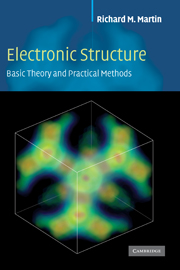Book contents
- Frontmatter
- Contents
- Preface
- Acknowledgments
- Notation
- Part I Overview and background topics
- Part II Density functional theory
- Part III Important preliminaries on atoms
- 10 Electronic structure of atoms
- 11 Pseudopotentials
- Part IV Determination of electronic structure: the three basic methods
- Part V Predicting properties of matter from electronic structure – recent developments
- Appendix A Functional equations
- Appendix B LSDA and GGA functionals
- Appendix C Adiabatic approximation
- Appendix D Response functions and Green's functions
- Appendix E Dielectric functions and optical properties
- Appendix F Coulomb interactions in extended systems
- Appendix G Stress from electronic structure
- Appendix H Energy and stress densities
- Appendix I Alternative force expressions
- Appendix J Scattering and phase shifts
- Appendix K Useful relations and formulas
- Appendix L Numerical methods
- Appendix M Iterative methods in electronic structure
- Appendix N Code for empirical pseudopotential and tight-binding
- Appendix O Units and conversion factors
- References
- Index
11 - Pseudopotentials
from Part III - Important preliminaries on atoms
Published online by Cambridge University Press: 05 June 2012
- Frontmatter
- Contents
- Preface
- Acknowledgments
- Notation
- Part I Overview and background topics
- Part II Density functional theory
- Part III Important preliminaries on atoms
- 10 Electronic structure of atoms
- 11 Pseudopotentials
- Part IV Determination of electronic structure: the three basic methods
- Part V Predicting properties of matter from electronic structure – recent developments
- Appendix A Functional equations
- Appendix B LSDA and GGA functionals
- Appendix C Adiabatic approximation
- Appendix D Response functions and Green's functions
- Appendix E Dielectric functions and optical properties
- Appendix F Coulomb interactions in extended systems
- Appendix G Stress from electronic structure
- Appendix H Energy and stress densities
- Appendix I Alternative force expressions
- Appendix J Scattering and phase shifts
- Appendix K Useful relations and formulas
- Appendix L Numerical methods
- Appendix M Iterative methods in electronic structure
- Appendix N Code for empirical pseudopotential and tight-binding
- Appendix O Units and conversion factors
- References
- Index
Summary
Summary
The fundamental idea of a “pseudopotential” is the replacement of one problem with another. The primary application in electronic structure is to replace the strong Coulomb potential of the nucleus and the effects of the tightly bound core electrons by an effective ionic potential acting on the valence electrons. A pseudopotential can be generated in an atomic calculation and then used to compute properties of valence electrons in molecules or solids, since the core states remain almost unchanged. Furthermore, the fact that pseudopotentials are not unique allows the freedom to choose forms that simplify the calculations and the interpretation of the resulting electronic structure. The advent of “ab initio norm-conserving” and “ultrasoft” pseudopotentials has led to accurate calculations that are the basis for much of the current research and development of new methods in electronic structure, as described in the following chapters.
Many of the ideas originated in the orthogonalized plane wave (OPW) approach that casts the eigenvalue problem in terms of a smooth part of the valence functions plus core (or core-like) functions. The OPW method has been brought into the modern framework of total energy functionals by the projector augmented wave (PAW) approach that uses pseudopotential operators but keeps the full core wavefunctions.
Scattering amplitudes and pseudopotentials
The scattering properties of a localized spherical potential at any energy ε can be formulated concisely in terms of the phase shift ηl(ε), which determines the cross-section and all properties of the wavefunction outside the localized region.
- Type
- Chapter
- Information
- Electronic StructureBasic Theory and Practical Methods, pp. 204 - 232Publisher: Cambridge University PressPrint publication year: 2004
- 7
- Cited by



